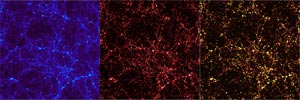Herschel finds less dark matter but more stars

The calculated distribution of dark matter<br>
The galaxies are far away and each boasts some 300 billion times the mass of the Sun. The size challenges current theory that predicts a galaxy has to be more than ten times larger, 5000 billion solar masses, to be able form large numbers of stars.
The new result is published today in a paper by Alexandre Amblard, University of California, Irvine, and colleagues.
Most of the mass of any galaxy is expected to be dark matter, a hypothetical substance that has yet to be detected but which astronomers believe must exist to provide sufficient gravity to prevent galaxies ripping themselves apart as they rotate.
Current models of the birth of galaxies start with the accumulation of large amounts of dark matter. Its gravitational attraction drags in ordinary atoms. If enough atoms accumulate, a ‘starburst’ is ignited, in which stars form at rates 100–1000 times faster than in our own galaxy does today.
“Herschel is showing us that we don’t need quite so much dark matter as we thought to trigger a starburst,” says Asantha Cooray, University of California, Irvine, a co-author on today’s paper.
This discovery was made by analysing infrared images taken by Herschel’s SPIRE (Spectral and Photometric Imaging Receiver) instrument at wavelengths of 250, 350, and 500 microns. These are roughly 1000 times longer than the wavelengths visible to the human eye and reveal galaxies that are deeply enshrouded in dust.
“With its very high sensitivity to the far-infrared light emitted by these young, enshrouded starburst galaxies, Herschel allows us to peer deep into the Universe and to understand how galaxies form and evolve,” says Göran Pilbratt, the ESA Herschel project scientist.
There are so many galaxies in Herschel’s images that they overlap, creating a fog of infrared radiation known as the cosmic infrared background. The galaxies are not distributed randomly but follow the underlying pattern of dark matter in the Universe, and so the fog has a distinctive pattern of light and dark patches.
The calculated distribution of dark matter
Analysis of the brightness of the patches in the SPIRE images has shown that the star-formation rate in the distant infrared galaxies is 3–5 times higher than previously inferred from visible-wavelength observations of similar, very young galaxies by the Hubble Space Telescope and other telescopes.
Further analysis and simulations have shown that this smaller mass for the galaxies is a sweet spot for star formation. Less massive galaxies find it hard to form more than a first generation of stars before fizzling out. At the other end of the scale, more massive galaxies struggle because their gas cools rather slowly, preventing it from collapsing down to the high densities needed to ignite star formation.
But at this newly identified ‘just-right’ mass of a few hundred billion solar masses, galaxies can make stars at prodigious rates and thus grow rapidly.
“This is the first direct observation of the preferred mass scale for igniting a starburst,” says Dr Cooray.
Models of galaxy formation can now be adjusted to reflect these new results, and astronomers can take a step closer to understanding how galaxies – including our own –came into being.
Media Contact
All latest news from the category: Physics and Astronomy
This area deals with the fundamental laws and building blocks of nature and how they interact, the properties and the behavior of matter, and research into space and time and their structures.
innovations-report provides in-depth reports and articles on subjects such as astrophysics, laser technologies, nuclear, quantum, particle and solid-state physics, nanotechnologies, planetary research and findings (Mars, Venus) and developments related to the Hubble Telescope.
Newest articles

Webb captures top of iconic horsehead nebula in unprecedented detail
NASA’s James Webb Space Telescope has captured the sharpest infrared images to date of a zoomed-in portion of one of the most distinctive objects in our skies, the Horsehead Nebula….

Cost-effective, high-capacity, and cyclable lithium-ion battery cathodes
Charge-recharge cycling of lithium-superrich iron oxide, a cost-effective and high-capacity cathode for new-generation lithium-ion batteries, can be greatly improved by doping with readily available mineral elements. The energy capacity and…

Novel genetic plant regeneration approach
…without the application of phytohormones. Researchers develop a novel plant regeneration approach by modulating the expression of genes that control plant cell differentiation. For ages now, plants have been the…





















